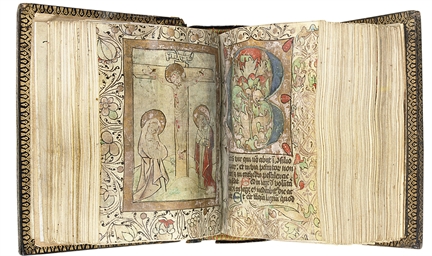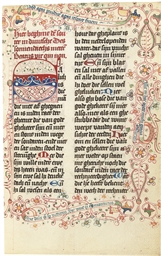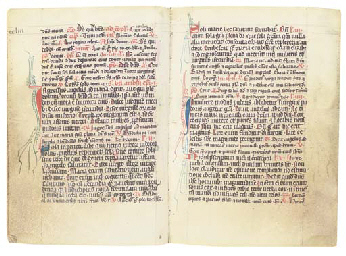BREVIARY, for the use of the Cistercian Abbey of Kamp, in Latin, DECORATED MANUSCRIPT ON VELLUM
BREVIARY, for the use of the Cistercian Abbey of Kamp, in Latin, DECORATED MANUSCRIPT ON VELLUM [North-west Germany, Abbey of Kamp, second half 15th century] 140 x 100mm. 366 leaves: 1 3 (?of 4, ?i pastedown concealed under paper), 2 7 (of 6 + i, folding table), 3 4 , 4-22 8 , 23 7 (of 6 + vii), 24-34 8 . 35 3 (of 4, iv cancelled blank), 36-45 8 , 46 2 , 47-48 8 , 49 4 (iv backed with paper), many quires with signatures using arabic numerals, COMPLETE, 26-28 lines written in a gothic bookhand between two verticals and two horizontals, ruled in black except for ff.12-59 ruled in red, justification: 93 x 61mm, rubrics in red with guide texts surviving in many margins, text capitals touched red, one- and two-line initials alternately in red or blue, one large blue initial flourished in red, three large decorated initials with staves of blue and yellow and maroon infills patterned with white extensively flourished in red (several leaves with original holes and repairs, some undone, irregular trimming of several leaves probably original, worming to first eight and last three leaves). 17th-century brown leather over wooden boards, fastener for strap on upper cover, red fore-edges (worn, lacking strap, stubs of indexing tabs remain). PROVENANCE: The Breviary is for Cistercian use, as stated at the heading of the Temporal, Incipit breviarium more cistercense , and Psalter, Incipit psalterium ad usum ordinis cisterciensis . The calendar shows that it was made for the Abbey of Kamp in the Wesel region of North Rhine-Westphalia (now Kamp-Lintfort). Founded in 1123, Kamp was the first Cistercian house in Germany and the mother-house of many subsequent foundations. The Dedicatio ecclesie Campen [ sis ] appears in the calendar on 8 January in blue, the highest ranking colour, and anniversaries of abbots of Kamp have been added: 6 April election in 1584 of Godefridus Draeck (d.1612); 8 May death in 1572 of Richardus Xantenensis 34th Abbot of Kamp (elected 1563); 30 May election of his successor, Johannes von Wachtendonck (d. 1584); at 23 September is noted the death of pater meus , the user's father, 1571. This is an additon to the list of sixty or so manuscripts known from Kamp, of which about forty survive, see S. Krämer, Handschriftenerbe des deutschen Mittelalters, I , 1989, pp.386-387. Kamp had a notable scriptorium that was especially active in the 15th century, as recorded in the Abbey's Chronicle, where the names of several scribes are preserved (see M. Dicks, Die Abtei Camp am Niederrhein , 1913). Most notable was the lay brother Wilhelm de Reno, fl . 1469-1487, scriptor egregius , who taught his art to some of his brethren and was on friendly terms with Heinrich von Kalkar, who as sub-prior and then abbot (1483-1499) actively fostered the scriptorium and library. Some indication of the scale of Kamp's book production is given by the 120 gold Rhine guilders' worth of unused parchment destroyed by fire in 1463. The variable quality of the parchment of this breviary and its limited decoration exemplify the economy thought appropriate for a book made for a member of the community, possibly by his own hand; see exh. cat. Buchmalerei der Zisterzienser, kulturelle Schätze aus sechs Jahrhunderten , Ordensmuseum Abtei Kamp, 1998, pp.28-34, where no 5 is a 15th-century compilation of practical texts for use at Kamp with similarly repaired and somewhat defective parchment. The Abbey, abandoned in the 1580s and reinhabited in 1640, was suppressed by Napoleon in 1802, when most of its books were sold at Duisburg. From the collection of comte Paul Durrieu, by descent to the present owner. CONTENT: Added prayers, including one to St Robert, founder of the Cistercians, in a late 16th-century hand on leaves ruled to the original pattern, ff.1-3; folding liturgical calendar table, f.4; calendar, ff.5-10; Prayers to saints, named and unnamed, ff.11-14; Temporal, from Advent to the 24th Sunday after Trinity, ff.15-173v; Sanctoral, from St Stephe
BREVIARY, for the use of the Cistercian Abbey of Kamp, in Latin, DECORATED MANUSCRIPT ON VELLUM
BREVIARY, for the use of the Cistercian Abbey of Kamp, in Latin, DECORATED MANUSCRIPT ON VELLUM [North-west Germany, Abbey of Kamp, second half 15th century] 140 x 100mm. 366 leaves: 1 3 (?of 4, ?i pastedown concealed under paper), 2 7 (of 6 + i, folding table), 3 4 , 4-22 8 , 23 7 (of 6 + vii), 24-34 8 . 35 3 (of 4, iv cancelled blank), 36-45 8 , 46 2 , 47-48 8 , 49 4 (iv backed with paper), many quires with signatures using arabic numerals, COMPLETE, 26-28 lines written in a gothic bookhand between two verticals and two horizontals, ruled in black except for ff.12-59 ruled in red, justification: 93 x 61mm, rubrics in red with guide texts surviving in many margins, text capitals touched red, one- and two-line initials alternately in red or blue, one large blue initial flourished in red, three large decorated initials with staves of blue and yellow and maroon infills patterned with white extensively flourished in red (several leaves with original holes and repairs, some undone, irregular trimming of several leaves probably original, worming to first eight and last three leaves). 17th-century brown leather over wooden boards, fastener for strap on upper cover, red fore-edges (worn, lacking strap, stubs of indexing tabs remain). PROVENANCE: The Breviary is for Cistercian use, as stated at the heading of the Temporal, Incipit breviarium more cistercense , and Psalter, Incipit psalterium ad usum ordinis cisterciensis . The calendar shows that it was made for the Abbey of Kamp in the Wesel region of North Rhine-Westphalia (now Kamp-Lintfort). Founded in 1123, Kamp was the first Cistercian house in Germany and the mother-house of many subsequent foundations. The Dedicatio ecclesie Campen [ sis ] appears in the calendar on 8 January in blue, the highest ranking colour, and anniversaries of abbots of Kamp have been added: 6 April election in 1584 of Godefridus Draeck (d.1612); 8 May death in 1572 of Richardus Xantenensis 34th Abbot of Kamp (elected 1563); 30 May election of his successor, Johannes von Wachtendonck (d. 1584); at 23 September is noted the death of pater meus , the user's father, 1571. This is an additon to the list of sixty or so manuscripts known from Kamp, of which about forty survive, see S. Krämer, Handschriftenerbe des deutschen Mittelalters, I , 1989, pp.386-387. Kamp had a notable scriptorium that was especially active in the 15th century, as recorded in the Abbey's Chronicle, where the names of several scribes are preserved (see M. Dicks, Die Abtei Camp am Niederrhein , 1913). Most notable was the lay brother Wilhelm de Reno, fl . 1469-1487, scriptor egregius , who taught his art to some of his brethren and was on friendly terms with Heinrich von Kalkar, who as sub-prior and then abbot (1483-1499) actively fostered the scriptorium and library. Some indication of the scale of Kamp's book production is given by the 120 gold Rhine guilders' worth of unused parchment destroyed by fire in 1463. The variable quality of the parchment of this breviary and its limited decoration exemplify the economy thought appropriate for a book made for a member of the community, possibly by his own hand; see exh. cat. Buchmalerei der Zisterzienser, kulturelle Schätze aus sechs Jahrhunderten , Ordensmuseum Abtei Kamp, 1998, pp.28-34, where no 5 is a 15th-century compilation of practical texts for use at Kamp with similarly repaired and somewhat defective parchment. The Abbey, abandoned in the 1580s and reinhabited in 1640, was suppressed by Napoleon in 1802, when most of its books were sold at Duisburg. From the collection of comte Paul Durrieu, by descent to the present owner. CONTENT: Added prayers, including one to St Robert, founder of the Cistercians, in a late 16th-century hand on leaves ruled to the original pattern, ff.1-3; folding liturgical calendar table, f.4; calendar, ff.5-10; Prayers to saints, named and unnamed, ff.11-14; Temporal, from Advent to the 24th Sunday after Trinity, ff.15-173v; Sanctoral, from St Stephe


.jpg?w=400)



.jpg)




.jpg)

.jpg)

Testen Sie LotSearch und seine Premium-Features 7 Tage - ohne Kosten!
Lassen Sie sich automatisch über neue Objekte in kommenden Auktionen benachrichtigen.
Suchauftrag anlegen